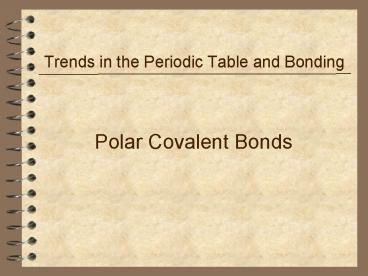Polar Covalent Bonds - PowerPoint PPT Presentation
1 / 9
Title:
Polar Covalent Bonds
Description:
Trends in the Periodic Table and Bonding Polar Covalent Bonds Covalent Bonding A covalent bond is a shared pair of electrons electrostatically attracted to the ... – PowerPoint PPT presentation
Number of Views:266
Avg rating:3.0/5.0
Title: Polar Covalent Bonds
1
Polar Covalent Bonds
- Trends in the Periodic Table and Bonding
2
Covalent Bonding
A covalent bond is a shared pair of electrons
electrostatically attracted to the positive
nuclei of two atoms.
Both nuclei try to pull the electrons towards
themselves
The atoms achieve a stable outer electron
arrangement (a noble gas arrangement) by sharing
electrons.
This is like a tug-of-war where both sides are
pulling on the same object. It creates a strong
bond between the two atoms.
3
Covalent Bonding
Picture a tug-of-war
If both teams pull with the same force the
mid-point of the rope will not move.
4
Pure Covalent Bond
This even sharing of the rope can be compared to
a pure covalent bond, where the bonding pair of
electrons are held at the mid-point between the
nuclei of the bonding atoms.
5
Covalent Bonding
What if it was an uneven tug-of-war?
The team on the right are far stronger, so will
pull the rope harder and the mid-point of the
rope will move to the right.
6
Polar Covalent Bond
A polar covalent bond is a bond formed when the
shared pair of electrons in a covalent bond are
not shared equally.
This is due to different elements having
different electronegativities.
7
Polar Covalent Bond
e.g. Hydrogen Iodide
If hydrogen iodide contained a pure covalent
bond, the electrons would be shared equally as
shown above.
This makes iodine slightly negative and hydrogen
slightly positive. This is known as a dipole.
However, iodine has a higher electronegativity
and pulls the bonding electrons towards
itself (winning the tug-of-war)
8
Polar Covalent Bond
In general, the electrons in a covalent bond are
not equally shared.
e.g.
3.0
2.5
d- indicates where the bonding electrons are most
likely to be found.
9
Polar Covalent Bond
Consider the polarities of the following bonds
Difference
Electronegativities
Bond
0.5
0
1.4
Increasing Polarity
Complete a similar table for C-N, C-O and P-F
bonds.































